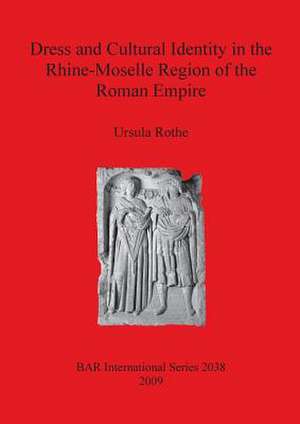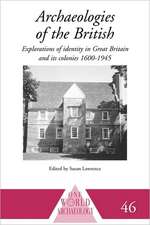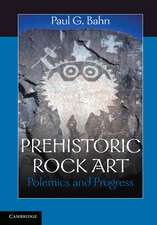Dress and Cultural Identity in the Rhine-Moselle Region of the Roman Empire: Bar S, cartea 2038
Autor Ursula Rotheen Limba Engleză Paperback – 30 noi 2009
Din seria Bar S
-
 Preț: 297.06 lei
Preț: 297.06 lei -
 Preț: 422.55 lei
Preț: 422.55 lei - 8%
 Preț: 415.32 lei
Preț: 415.32 lei - 9%
 Preț: 796.99 lei
Preț: 796.99 lei - 8%
 Preț: 483.76 lei
Preț: 483.76 lei - 8%
 Preț: 570.26 lei
Preț: 570.26 lei -
 Preț: 305.69 lei
Preț: 305.69 lei -
 Preț: 425.38 lei
Preț: 425.38 lei - 8%
 Preț: 428.72 lei
Preț: 428.72 lei -
 Preț: 323.11 lei
Preț: 323.11 lei -
 Preț: 355.89 lei
Preț: 355.89 lei -
 Preț: 299.89 lei
Preț: 299.89 lei -
 Preț: 296.86 lei
Preț: 296.86 lei -
 Preț: 297.81 lei
Preț: 297.81 lei - 8%
 Preț: 495.26 lei
Preț: 495.26 lei -
 Preț: 311.88 lei
Preț: 311.88 lei - 8%
 Preț: 682.54 lei
Preț: 682.54 lei - 8%
 Preț: 593.15 lei
Preț: 593.15 lei - 8%
 Preț: 411.86 lei
Preț: 411.86 lei - 8%
 Preț: 603.13 lei
Preț: 603.13 lei - 9%
 Preț: 1173.12 lei
Preț: 1173.12 lei - 9%
 Preț: 748.78 lei
Preț: 748.78 lei - 8%
 Preț: 644.68 lei
Preț: 644.68 lei -
 Preț: 403.62 lei
Preț: 403.62 lei -
 Preț: 411.52 lei
Preț: 411.52 lei - 9%
 Preț: 724.21 lei
Preț: 724.21 lei - 9%
 Preț: 1147.93 lei
Preț: 1147.93 lei - 9%
 Preț: 737.89 lei
Preț: 737.89 lei -
 Preț: 311.88 lei
Preț: 311.88 lei - 9%
 Preț: 685.88 lei
Preț: 685.88 lei -
 Preț: 423.87 lei
Preț: 423.87 lei - 8%
 Preț: 552.28 lei
Preț: 552.28 lei - 5%
 Preț: 295.93 lei
Preț: 295.93 lei -
 Preț: 392.77 lei
Preț: 392.77 lei - 8%
 Preț: 462.17 lei
Preț: 462.17 lei - 8%
 Preț: 429.42 lei
Preț: 429.42 lei -
 Preț: 298.35 lei
Preț: 298.35 lei - 8%
 Preț: 463.02 lei
Preț: 463.02 lei - 9%
 Preț: 876.45 lei
Preț: 876.45 lei - 8%
 Preț: 513.68 lei
Preț: 513.68 lei - 9%
 Preț: 724.89 lei
Preț: 724.89 lei - 8%
 Preț: 439.94 lei
Preț: 439.94 lei - 9%
 Preț: 847.78 lei
Preț: 847.78 lei - 8%
 Preț: 428.57 lei
Preț: 428.57 lei - 8%
 Preț: 503.00 lei
Preț: 503.00 lei -
 Preț: 299.89 lei
Preț: 299.89 lei - 8%
 Preț: 614.84 lei
Preț: 614.84 lei -
 Preț: 267.08 lei
Preț: 267.08 lei -
 Preț: 355.13 lei
Preț: 355.13 lei - 9%
 Preț: 1059.67 lei
Preț: 1059.67 lei
Preț: 527.27 lei
Preț vechi: 573.12 lei
-8% Nou
Puncte Express: 791
Preț estimativ în valută:
100.96€ • 105.13$ • 83.76£
100.96€ • 105.13$ • 83.76£
Carte tipărită la comandă
Livrare economică 13-27 februarie
Preluare comenzi: 021 569.72.76
Specificații
ISBN-13: 9781407306155
ISBN-10: 1407306154
Pagini: 179
Dimensiuni: 208 x 295 x 15 mm
Greutate: 0.68 kg
Ediția:New.
Editura: British Archaeological Association
Seria Bar S
ISBN-10: 1407306154
Pagini: 179
Dimensiuni: 208 x 295 x 15 mm
Greutate: 0.68 kg
Ediția:New.
Editura: British Archaeological Association
Seria Bar S
Notă biografică
Ursula Rothe















